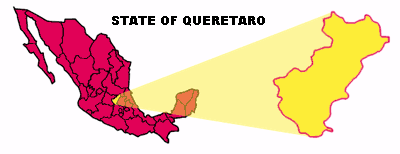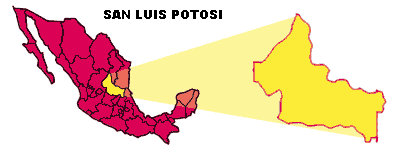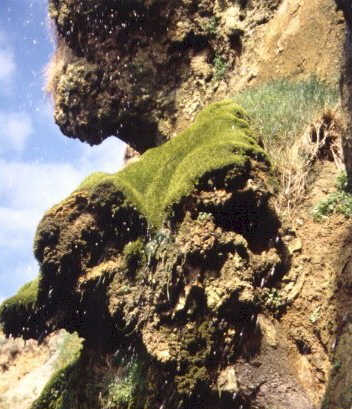(cliquer sur le drapeau pour la
version : )
go to : Home
index of species
TAXONOMY:
Family :
Lentibulariaceae
Genus :
Pinguicula
Name
: Pinguicula calderoniae
Sub-classification
(Casper)
: link
Publication :
By Dr. Sergio Zamudio Ruiz : " Una especie nueva notable de Pinguicula (lentibulariaceae)
de los estados de Queretaro y San Luis Potosi, Mexico" in
Bol.Soc.Bot.Mex.68:85 (2001)
Etymology
: The name of the plant referred to Maestra Gracelia Calderon de Rzedowski,
a Mexican Botanist.
DESCRIPTION :
Herba
perennis. Folia radicalia rosulata integerrima biformia; rosula hiemis
hypogaea 5 - 15 mm diametro bulbiformis ex foliis numerosis (6 - 30) composita,
foliis squamiformibus obtrullatis vel ellipticis apice obtusis mucronatis
glabriusculis 3 - 10 mm longis, 1.5 - 4 mm latis; rosula aestatis (3) 4 - 8
foliis erectis composita, foliis lineari-lanceolatis, proximaliter
distaliterque gradatim attenuatis, superne glandulis sessilibus dense vestitis
et glandulis stipitatis modice dense vestitis, (60) 80 - 260 mm longis, 3 -
8.5 mm latis margine valde revolutis. Pedunculi 1 - 3, erecti, glandulis
stipitatis obsiti, 60 - 150 mm alti, uniflori. Flores 20 - 35 mm longi (clacari
incluso). Calyx bilabiatus extus glandulis stipitatis obsitus; labio supero
usque ad basim trilobo, lobis usque ad 1/4 - 1/2 longitudinis divisis,
lanceolatis vel triangulatis. Corolla bilabiata rubro-purpurea extus glandulis
stipitatis dispersis obsita, lobis oblongis vel anguste oblongis, obtusis vel
rotundatis 5 - 8 mm longis, 3 - 6 mm latis. Tubus longe infundibuliformis,
albus vel ex purpureo albus 7 - 10 mm longs, intus pilosus basim tubi versus
pilis brevioribus. Calcar 7 - 16 mm longum. Stamina 2 - 2.5 mm longa; pollen
(4) 5 (6) - colporatum. Ovarium subglobosum glandulis stipitatis dispersis
obsitum. Stigma violaceum bilabiatum; labio infero suborbiculato dentato.
Capsula subglobosa 3 - 4 mm diametro. Semina fusiformia +/- 1 mm longa +/-
0.25 mm lata, alveolata.
translation
:
-
soon -
ORIGIN AND HISTORY :
Explorations in valleys in cloud forest in
the border of Queretaro and San Luis Potosi states revealed a Pinguicula
with a bilabiate corolla with long-infundibuliform tube, as long as or shorter
than the spur, placed in subgenus Pinguicula, section longitibus
and described as a new species under the name Pinguicula calderoniae.
This taxon
is crealy differentiated from other members of this group by its long
lanceolate-linear summer leaves ((60) 80 - 260 mm !), which is unique in the
section.
Map / LOCALISATION :
Two
locations are noted in the publication :
- From Mexico, Queretaro. Municipio de Landa,
extrem north of the Llano Chiquito.

(click
on the map for better location and relief map)
-
From Mexico, San Luis Potosi, Municipio de Xilitla; Llano del Cornejo.

(click
on the map for better location and relief map)
HABITAT:
On calcareous
rocks in the cloud forest (bosque mesofil de montana). Plants grow at altitude
of 2200 to 2300m. According to the publication, Pinguicula calderoniae
grows on wet calcium carbonate concretions, on vertical calcareous walls, in
limestone cracks.
TEMPERATURE
and PRECIPITATIONS :
Click
on the graph to enlarge and see the graph of normal precipitation and normal average temperatures.
Normal values are 30-year averages for the period 1961 to 1990. The weather
stations are grouped by region (see map of weather
stations).
Introduction in culture
:
Except in a Mexican collection, this species seems to have been introduced
in-vitro in 2009 in Europe.
CULTURE
AND MULTIPLICATION :
(North
hemisphere, France
near Paris, in a polycarbonate greenhouse - see the map
-)
Life
cycle :
Flowering in June in habitat with young summer leaves and last winter leaves.
In culture (in Mexico), the summer rosette last until October and the winter
rosette is produced in november. The compact winter rosette remains until May
of the following year.
Media
: I will use a 100 % mineral media : 2 perlite, 2 vermiculite,
1 small sand (for aquarium), 1 fine white sand, 1 pouzzolane (volcanic lava),
1 aqualit (expansed ceramic for aquarium). The aqualit can be replaced by 1 of
pouzzolane. Plants in this media grow slower but have a stronger root system.
Pot
:
plastic,
colour terracotta, diameter 12.5cm, height 12cm.
Cultivation
:
no data. I will work as for all other Mexican Pinguicula.
Multiplication
:
no data. The
plants should be propagated easily
using non-carnivorous leaves separated from the rosette at the end of
winter. You only have to carefully tear out the totality of the leaf including
the white base as the plantlets will sprout from this area.
PICTURES: (click to
enlarge)
|
.jpg)
Pinguicula
calderoniae in culture in a greenhouse in Mexico (bottom), young
summer leaves.
Photo
: Ed. Read.
-
October 2003 - |

tufa
: calcium carbonate
A
chemical sedimentary rock composed of calcium carbonate, formed by
evaporation as a surficial, spongy, porous, semifriable incrustation
around the mouth of a hot or cold spring or seep, or along a stream
carrying calcium carbonate in solution, and exceptionally as a thick,
bulbous, concretionary or compact deposit in a lake or along its shore.
It may also be precipitated by algae or bacteria.
|
|
.jpg)
Winter
rosette of Pinguicula calderoniae in S. Zamudio's collection.
Photo
: F. Rivadavia
|
.jpg)
Winter
rosette of Pinguicula calderoniae in S. Zamudio's collection.
Note the impressive long dried summer leaves.
Photo
: F. Rivadavia |
|
.jpg)
Type
specimen of Pinguicula calderoniae.
Photo
: F. Rivadavia |
.jpg)
Type
specimen of Pinguicula calderoniae.
Photo
: F. Rivadavia |
|
.jpg)
Type
specimen of Pinguicula calderoniae.
Photo
: F. Rivadavia |
|
|
Pinguicula calderoniae
in habitat
by Radek KASTNER.
Pinguicula calderionae can be found growing
with P. martinezii and P. moranensis. Plants grow on very
tall vertical rocky cliffs/mountains.
Sites of these three species are about 20 km from city of Xilitla, San
Luis Potosí state, Mexico in really steep mountains covered by really
nice and mystic misty forest on the top.
Road from Xilitla to La Trinidad is a very bad dirty road with many
holes and rocks only.
Between Xilitla and La Trinidad are another two villages in mountains
valleys. The way to Llano Conecho is very demanding and it has to be
crossed 3 mountain crests.
La Trinidad is an Eco Preserve, you have to pay money here to cross
"borderline".
Between La Trinidad and Llano Conecho is altitudinal difference another
150-200 m (???). |
|
.jpg)
General view on La Trinidad and
mountains behind.
Photo : Radek KASTNER
July-August 2009
|
|
.jpg)
Photo : Radek KASTNER
July-August 2009
|
|
.jpg)
Admission fee to La Trinidad Eco Preserve
Photo : Radek KASTNER
July-August 2009
|
.jpg)
Gathering point of visitors.
Photo : Radek KASTNER
July-August 2009 |
|
.jpg)
Typical
house of native people, made from wood, with earthen floor, but with
solar collectors !!!
Photo : Radek KASTNER
July-August 2009
|
.jpg)
Surrounding
forest is full of epiphytic orchids and tillandsia.
Photo : Radek KASTNER
July-August 2009
|
.jpg)
Surrounding
forest is full of epiphytic orchids and tillandsia.
Photo : Radek KASTNER
July-August 2009 |
.jpg)
Dead or dry
tree trunks on the picture are remains of pine trees which were damaged
by last big wildfire about 15 years ago...
Photo : Radek KASTNER
July-August 2009 |
.jpg)
EL Lllano Conecho : Llano is a highland plateau.
On the 4
following pictures you can see typical habitat of Llano Conecho and its
surrounding.
Photo : Radek KASTNER
July-August 2009 |
.jpg)
Mist on Lllano Conecho
Photo : Radek KASTNER
July-August 2009 |
.jpg)
El Lllano Conecho.
Plants
grow on very tall vertical rocky cliffs/mountains.
Photo : Radek KASTNER
July-August 2009 |
.jpg)
Agave strica and habitat in Lllano Conecho.
Photo : Radek KASTNER
July-August 2009
|
.jpg)
The first
location where P. calderoniae can be found. There are two
different sites near to/or on the Llano Conecho. This location may have
been visited for the first time by Europeans during our expedition .
Photo : Radek KASTNER
July-August 2009 |
.jpg)
Another
location of P. calderoniae. This location could be the site found
by Fernando.
Photo : Radek KASTNER
July-August 2009 |
.jpg)
Plants grow
very high, most of them are inaccessible, common plants together with
butterworts were there Agave stricta.
Photo : Radek KASTNER
July-August 2009
|
.jpg)
Plants grow
very high, most of them are inaccessible, common plants together with
butterworts were there Agave stricta.
Photo : Radek KASTNER
July-August 2009 |
.jpg)
Leaves are
long and very narrow and hang down, plants grow on the rock crevices
with hidden bulbs, colour of the leaves differs from green to bright
reddish.
Photo : Radek KASTNER
July-August 2009
|
.jpg)
The vertical cliff where
plants grow.
Photo : Radek KASTNER
July-August 2009
|
.jpg)
Leaves are
long and very narrow and hang down, plants grow on the rock crevices
with hidden bulbs, colour of the leaves differs from green to bright
reddish.
Photo : Radek KASTNER
July-August 2009
|
.jpg)
Normal plant
has only a few leaves (from 3 to 5 at maximum!), if you see more leaves
on a pictures, there are always more plants at the same place !
Photo : Radek KASTNER
July-August 2009 |
.jpg)
Comparing of size with hand - more than 20 cm...
Photo : Radek KASTNER
July-August 2009
|
.jpg)
Pinguicula
calderionae, winter bulb, starting to grow.
Photo : Radek KASTNER
July-August 2009 |
.jpg)
Pinguicula
calderionae, regular dark red winter bulb.
Photo : Radek KASTNER
July-August 2009 |
.jpg)
We found
P. calderoniae growing with P. martinezii together (in some
lower parts of vertical cliff).
Photo : Radek KASTNER
July-August 2009
|
.jpg)
Leaves are
long and very narrow and hang down, plants grow on the rock crevices
with hidden bulbs, colour of the leaves differs from green to bright
reddish.
Photo : Radek KASTNER
July-August 2009 |
.jpg)
This picture
is not sharp enough, but plants were too far - it was interesting, that
some of plants hang vertically down from overhanging cliff...
Photo : Radek KASTNER
July-August 2009
|


.jpg)

.jpg)
.jpg)
.jpg)
.jpg)
.jpg)
.jpg)
.jpg)
.jpg)
.jpg)
.jpg)
.jpg)
.jpg)
.jpg)
.jpg)
.jpg)
.jpg)
.jpg)
.jpg)
.jpg)
.jpg)
.jpg)
.jpg)
.jpg)
.jpg)
.jpg)
.jpg)
.jpg)
.jpg)
.jpg)
.jpg)
.jpg)